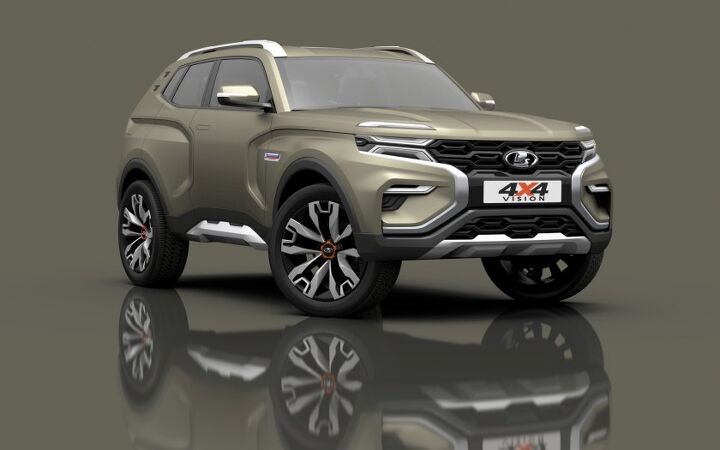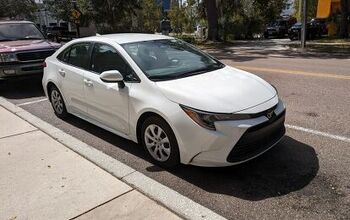Niva No More? Lada Concept Vehicle Heralds the Demise of a Communist Classic

We’ve all seen movies set in the perpetually grey, bitterly cold Soviet Union (later Hollywood films featuring Russia were apparently allowed to show sunlight), but if you lived north of the border a few decades ago, it wasn’t just the weather that looked familiar.
Lada Canada imported Iron Curtain cars for two decades (1979 to 1997), offering rudimentary, pinko automobiles to Canadian cheapskates for very few kopeks. Your author recalls entering the high school library at the dawn of the internet age and slowly booting up the Lada Canada website, where a five-door Samara was advertised for $4,995. Few of these showed up on local roads, as Hyundai offered slightly better no-cost transportation options.
However, there was one Lada vehicle that can truly be considered a classic, and it’s the one everyone remembers best. Sadly, after more than 40 years of production, the virtually unchanged Niva (now known simply as the 4×4) seems destined, like the Berlin Wall, to pass into history.
Last week, Lada revealed a concept vehicle that aims to bring the Niva/4×4 into the 21st century, just a couple of decades late. The 4×4 Vision concept heralds a successor to the classic, but not very safe SUV, borrowing styling cues seen on the popular (in Russia) Vesta sedan and wagon and XRAY crossover.
Both of those vehicles, as well as the concept, are the work of Steve Mattin, the British designer who hopped to Lada parent company AvtoVAZ (itself owned by the Renault-Nissan-Mitsubishi Alliance) after stints at Mercedes-Benz and Volvo. With his help, Lada was able to modernize its lineup and regain lost domestic market share. There’s nothing Cold War-era about the design of the Vesta or XRAY, and the same can be said of the 4×4 Vision.
“We are preparing LADA’s future. Showing 4×4 Vision we demonstrate the potential of a unique, expressive, bold and energetic design embodied in a new SUV drawing the inspiration from the legendary LADA 4×4”, said Mr. Mattin in a clearly translated statement.
Popular with tankies the world over but revered in its home country, the Niva entered production in 1977 after years of development. In the early 1970s, the Soviet Premier declared that his country’s auto industry must build a rugged yet “civilized” vehicle for proles — hardy, hopefully secular farming types — living in remote oblasts far from the gleaming lights of Moscow and St. Petersburg Leningrad.
Russian automaker VAZ developed the vehicle’s four-wheel drive system and suspension (independent in front, five-link live axle in the rear), crafted a simple body, and tossed in whatever Fiat-sourced parts were kicking around from its existing vehicles. Engineers then torture-tested the Niva in both Siberia and the Ural Mountains, where even experienced hikers can die unexplained, terrifying deaths. Eventually, the Niva was ready for prime time, which in the Soviet Union probably involved a lot of state-run television programming.
The model, with its 1.6-liter four-cylinder and four-speed manual transmission, soldiered on through the 1980s and into a new era of capitalism, after which Lada made changes in 1993 to bring it up to date with the norms of the previous decade. Four speeds became five, the engine grew by one tenth of a liter and adopted a single-point fuel injection system designed by General Motors, and other minor changes abounded. Outwardly, it was still a Niva. Unfortunately, the model name eventually became the property of GM through a Chevrolet-AvtoVAZ joint venture, so Lada adopted the “4×4” name for its little box.
Currently offered in three- and five-door form, still with a sole 1.7-liter, eight-valve engine (83 hp, 95 lb-ft), the Niva/4×4 spawned many variants — including military vehicles and a pickup — that never made it to export markets.
Before the Niva supply dried up on these shores, importers would add decadent Western content, most of it exterior appearance add-ons, and market them as the Niva Cossack. The name always made me pictured a big, furry hat. Simple, rugged, and distinctive (Seventies orange and olive green were popular colors, I recall, though rusty white seemed commonplace, too), the Niva was the vehicle you bought if a Blazer or Bronco seemed too dear, or if a Suzuki Samurai seemed too flimsy.
Every now and then I search for one online, and one inevitably appears within an hour’s drive of Montreal. Suffice it to say that the ravages of time and weather have not been kind to the remaining fleet.
Lada made sure to include certain heritage cues in the 4×4 Vision’s designs, which will no doubt carry over when the production models appears. When that will be remains a mystery. Situating the turn signals above the headlights, at the leading edge of the hood, is the biggest nod to Nivas of yore, as well as the upright grille. As the first Niva that comes to mind is the classic three-door bodystyle, Lada’s concept keeps its rear openings somewhat hidden, with concealed door handles. Phoney vents adorn the C-pillar.
Anyway, as you’re not likely to see Lada suddenly enter the U.S. market, this information is likely of little use of you. But it just goes to show that nothing lasts forever — not in the automotive realm (as the recent death of the Land Rover Defender already showed), and not even in Russia. Our time, like the Niva’s, will come.
[Images: AvtoVAZ Group]

More by Steph Willems
Latest Car Reviews
Read moreLatest Product Reviews
Read moreRecent Comments
- Zerofoo No.My wife has worked from home for a decade and I have worked from home post-covid. My commute is a drive back and forth to the airport a few times a year. My every-day predictable commute has gone away and so has my need for a charge at home commuter car.During my most recent trip I rented a PHEV. Avis didn't bother to charge it, and my newly renovated hotel does not have chargers on the property. I'm not sure why rental fleet buyers buy plug-in vehicles.Charging infrastructure is a chicken and egg problem that will not be solved any time soon.
- Analoggrotto Yeah black eyeliner was cool, when Davey Havok was still wearing it.
- Dave M. My sweet spot is $40k (loaded) with 450 mile range.
- Master Baiter Mass adoption of EVs will require:[list=1][*]400 miles of legitimate range at 80 MPH at 100°F with the AC on, or at -10°F with the cabin heated to 72°F. [/*][*]Wide availability of 500+ kW fast chargers that are working and available even on busy holidays, along interstates where people drive on road trips. [/*][*]Wide availability of level 2 chargers at apartments and on-street in urban settings where people park on the street. [/*][*]Comparable purchase price to ICE vehicle. [/*][/list=1]
- Master Baiter Another bro-dozer soon to be terrorizing suburban streets near you...






































Comments
Join the conversation
Still see a Niva (Cossack edition) in the area around York University in Toronto. Of course Lada's head office was also in that area and as I have mentioned the large Lada sign and logo are still on 2 sides of the office tower where it was located. Not sure if it costs too much to remove it, if it is kept on for nostalgic reasons, or if the building's owner expects Lada to return? Just like the Trabant featured in Sajeev's post this week, the Lada was built with 'in field service' in mind. Although as GTem mentions there is/was nearly always something that requires maintenance/repair it is quite easy and simple to do so. I would bet that this new 'Niva' does not retain one of the most endearing qualities of the original, which is the 'crank start' that Ladas imported to Canada (with the exception of the Samara?) had.
I had a Lada sedan, favorite thing was the seatbelts, they didn't have a metal tab you inserted the webbing under a hook and latched it down- confused the heck out of passengers